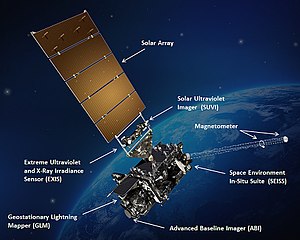GOES-16

GOES-16, yang sebelumnya dikenal sebagai GOES-R sebelum mencapai orbit geostasioner, merupakan satelit pertama dari rangkaian Satelit Lingkungan Operasional Geostasioner (GOES) seri GOES-R yang dioperasikan oleh NASA dan Badan Kelautan dan Atmosfer Nasional (NOAA). GOES-16 berfungsi sebagai satelit cuaca geostasioner operasional di posisi GOES Timur pada 75,2°W, yang menyediakan pandangan yang berpusat di Benua Amerika. GOES-16 menyediakan citra Bumi dengan resolusi spasial dan temporal yang tinggi melalui 16 pita spektral pada panjang gelombang tampak dan inframerah menggunakan Advanced Baseline Imager (ABI). Geostationary Lightning Mapper (GLM) milik GOES-16 merupakan pemeta petir operasional pertama yang diterbangkan dalam orbit geostasioner. Wahana antariksa ini juga dilengkapi dengan empat instrumen ilmiah lainnya untuk memantau cuaca antariksa dan Matahari.
Desain dan instrumentasi GOES-16 dimulai pada tahun 1999 dan dimaksudkan untuk memenuhi persyaratan utama satelit NOAA yang diterbitkan tahun itu. Setelah hampir satu dekade perencanaan instrumen, fabrikasi wahana antariksa dikontrakkan ke Lockheed Martin Space Systems pada tahun 2008; konstruksi GOES-16 dimulai pada tahun 2012 dan berlangsung hingga tahun 2014 ketika satelit memasuki fase pengujian. Setelah beberapa kali penundaan peluncuran, GOES-16 diluncurkan dari Cape Canaveral pada tanggal 19 November 2016 dengan menumpang United Launch Alliance (ULA) Atlas V. Wahana antariksa tersebut mencapai orbit geostasioner awal beberapa hari kemudian, memulai fase pemeriksaan dan validasi non-operasional selama setahun. Pada bulan November 2017, GOES-16 mulai bergeser ke posisi operasional GOES East, dan dinyatakan beroperasi penuh pada tanggal 18 Desember 2017. Satelit tersebut diharapkan memiliki masa operasional sepuluh tahun, dengan lima tahun tambahan sebagai cadangan untuk wahana antariksa GOES berikutnya.[1][2][3][4][5][6][7][8][9][10][11]
Instrumen
[sunting | sunting sumber]- Earth-facing
- Sun-facing
- Space environment
- Magnetometer (MAG)
- Space Environment In-Situ Suite (SEISS)
Lihat pula
[sunting | sunting sumber]- Satelit pengamat Bumi
- Satelit cuaca
- Remote sensing
- Radiometri
- Kalibrasi radiometrik
- Radiometer gelombang mikro
- Geostationary Extended Observations (GeoXO)
- Polar Operational Environmental Satellites
- Orbit geostasioner
- Orbit sinkron matahari
- Satelit Geostasioner
- Orbit beku
- Orbit polar
- Sistem navigasi satelit
- Meteosat
- MetOp
- Meteosat visible and infrared imager
- Himawari (satelit)
- Automatic identification system (AIS)
- Visible Infrared Imaging Radiometer Suite
- Ozone Mapping and Profiler Suite
- Thales Alenia Space
- EUMETSAT
- Deep Space Climate Observatory
- Advanced Himawari Imager
- National Oceanic and Atmospheric Administration
- Orbit geostasioner
- NASA
- Badan Antariksa Eropa
- Badan Meteorologi Jepang
- Geographic information system (GIS)
- Defense Meteorological Satellite Program
- Fengyun
- KOMPSAT
- Suomi National Polar-orbiting Partnership
- Advanced Technology Microwave Sounder
- Clouds and the Earth's Radiant Energy System
- Weather System Follow-on Microwave
- Badan Administrasi Antariksa Nasional Tiongkok
- Joint Polar Satellite System
- Yunhai-2
- Yunhai-3
- High throughput satellite
- Satelit komunikasi
- Organisasi Maritim Internasional
- Global Maritime Distress Safety System
- SOLAS Convention
- nCube (satelit)
- Tracking and Data Relay Satellite
- Pusat Pengendali Misi
- Stasiun Bumi
- Pengawas lalu lintas udara
- Tracking and Data Relay Satellite System
- Spacecraft Tracking and Data Acquisition Network
- European Data Relay System
- Laser Communications Relay Demonstration
- Near Earth Network
- Automatic Dependent Surveillance–Broadcast
- Automatic Identification System
- Proba-V
- Flightradar24
- Konstelasi satelit Iridium
- Global Positioning System
- GLONASS
- Galileo
- Topografi
- Peta topografi
- Topografi permukaan laut
- Batimetri
Referensi
[sunting | sunting sumber]- ^ Dunbar, Brian (3 August 2017). Lynn, Jenner, ed. "GOES Overview and History". GOES Satellite Network. NASA. Diakses tanggal 10 April 2018.
- ^ Gurka, James J.; Schmit, Timothy J. (June 2003). Menzel, W. Paul; Zhang, Wen-Jian; Le Marshall, John; Tokuno, Masami, ed. "Recommendations on the GOES-R Series From the GOES Users' Conferences". Proceedings of the SPIE: Applications with Weather Satellites. Applications with Weather Satellites. 4895: 95–102. Bibcode:2003SPIE.4895...95G. doi:10.1117/12.466817. Diarsipkan dari versi asli tanggal 29 April 2017. Diakses tanggal 14 April 2018.
- ^ "CIMSS GOES Activities". Cooperative Institute for Meteorological Satellite Studies. University of Wisconsin-Madison. 5 May 2011. Diakses tanggal 10 April 2018.
- ^ Schmit, Tim (14 March 2017). "Tim Schmit". NOAA Satellites and Information. University of Wisconsin-Madison. Diakses tanggal 10 April 2018.
- ^ Schmit, Tim; Menzel, Paul (September 1999). Spectral Band Selection for the Advanced Baseline Imager (ABI) (PPT) (Laporan). University of Wisconsin-Madison. Diakses tanggal 10 April 2018.
- ^ Schmit, Timothy J.; Li, Jun; Gurka, James (November 2003). "Introduction of the Hyperspectral Environmental Suite (HES) on GOES-R and beyond" (PDF). University of Wisconsin-Madison.
- ^ Schmit, Tim; Menzel, Paul; Woolf, Hal; Gunshor, Mat; Baum, Bryan; Sisko, Chris; Huang, Allen; Wade, Gary; Bachmeier, Scott; Gumley, Liam; Strabala, Kathy (February 2000). Spectral Band Selection for the Advanced Baseline Imager (ABI) (PDF) (Laporan). University of Wisconsin-Madison. Diakses tanggal 10 April 2018.
- ^ GOES Users' Conference (PDF) (Conference Report). NASA. 22–24 May 2001. Diarsipkan dari versi asli (PDF) tanggal 13 May 2017. Diakses tanggal 10 April 2018.
- ^ Schmit, Timothy J.; Gunshor, Mathew M.; Menzel, W. Paul; Gurka, James J.; Li, Jun; Bachmeier, A. Scott (August 2005). "Introducing the Next-Generation Advanced Baseline Imager on GOES-R". Bulletin of the American Meteorological Society. 86 (8): 1079–1096. Bibcode:2005BAMS...86.1079S. doi:10.1175/BAMS-86-8-1079
 .
.
- ^ Iannotta, Ben (18 September 2006). "NOAA Drops GOES-R Sensors". Space.com. Diakses tanggal 10 April 2018.
- ^ Singer, Jeremy (3 October 2006). "NOAA Tells Congress GOES R Cost Nearly Double Previous Estimate". SpaceNews. Diakses tanggal 19 November 2022.






